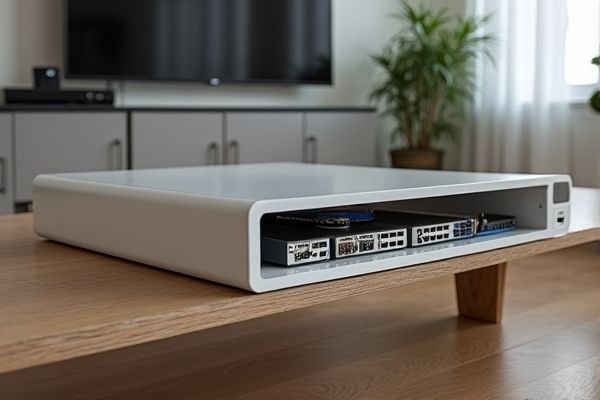
Wire management trays provide open, easily accessible organization for cables, ideal for environments where frequent changes or adjustments are necessary, while cable boxes offer enclosed storage to protect cables from dust and create a cleaner aesthetic. Discover which solution best fits Your setup and ensures optimal cable organization by reading the rest of the article.
Table of Comparison
| Feature | Wire Management Tray | Cable Box |
|---|---|---|
| Purpose | Organizes and routes cables under desks or along walls | Encloses and conceals cables for aesthetics and safety |
| Material | Metal or plastic, open-frame design | Plastic or metal, fully enclosed |
| Accessibility | Easy access for adding or removing cables | Limited access, typically requires opening to modify cables |
| Cable Capacity | High capacity for multiple cables and power strips | Moderate capacity, focused on hiding a smaller cable bundle |
| Installation | Mounted under desks or on walls | Placed on surfaces or mounted, often decorative |
| Use Case | Ideal for office setups and workstation cable routing | Best for home entertainment or small cable clusters |
| Price Range | Affordable to mid-range | Low to affordable |
Introduction to Wire Management Solutions
Wire management trays offer an open-structure solution designed for large-scale cable organization in office or industrial environments, providing easy access and ventilation. Cable boxes provide enclosed compartments ideal for concealing and protecting cables in residential or small office setups, enhancing aesthetic appeal while preventing dust accumulation. Selecting between wire management trays and cable boxes depends on the cable volume, accessibility requirements, and environmental conditions.
What is a Wire Management Tray?
A wire management tray is a sturdy, open-frame structure designed to organize and support cables beneath desks or along walls, preventing tangling and damage. Unlike enclosed cable boxes, trays offer easy access for cable adjustments and better airflow, reducing heat buildup around power cords. You can optimize your workspace by choosing a tray that fits your cable volume and layout, ensuring a cleaner and safer environment.
What is a Cable Box?
A cable box is a compact container designed to organize and conceal power strips, adapters, and cables, preventing clutter and improving safety in home or office environments. Unlike wire management trays, which are open and mounted under desks or along walls to route cables, cable boxes offer a closed solution, reducing dust accumulation and hiding unsightly wires from view. Cable boxes often feature ventilation holes to prevent overheating and easy-access lids for quick cable modifications or additions.
Key Differences Between Trays and Boxes
Wire management trays offer an open design ideal for organizing and securing cables in easily accessible, visible layouts, promoting airflow and quick adjustments. Cable boxes provide enclosed storage, concealing cables to reduce clutter and protect them from dust and damage while maintaining a tidier appearance. Your choice depends on whether you prioritize accessibility and ventilation or aesthetic concealment and protection for your wiring setup.
Installation Process: Tray vs Cable Box
Wire management trays offer a straightforward installation process, typically mounting under desks or along walls with screws or adhesive strips, allowing easy access for adding or removing cables. Cable boxes generally require more setup time as they often involve securing the box in a fixed position and organizing cables inside, making adjustments less flexible. Both solutions improve workspace organization, but trays provide quicker installation and better adaptability for ongoing cable management.
Space and Aesthetics Considerations
Wire management trays offer an open design that maximizes ventilation and easy access, making them ideal for environments where frequent cable adjustments are needed while maintaining a minimal footprint. Cable boxes provide a fully enclosed solution, concealing cables completely to enhance aesthetics and reduce visual clutter, particularly suited for living rooms or offices prioritizing a clean look. When prioritizing space efficiency, trays typically occupy less bulk under desks, whereas cable boxes can add volume but deliver superior cable concealment.
Safety and Cable Protection
Wire management trays offer superior safety by keeping cables elevated and organized, reducing trip hazards and preventing damage from crushing or abrasion. Cable boxes provide enclosed protection, shielding cables from dust, spills, and accidental contact, which is ideal for high-traffic areas or homes with pets and children. Choosing the right solution ensures your cables are both secure and prolongs their lifespan.
Maintenance and Accessibility
Wire management trays offer superior accessibility by allowing easy visual inspection and quick adjustments or additions to cables without disassembling components, which simplifies routine maintenance. Cable boxes provide a cleaner aesthetic by concealing cables but can complicate access, often requiring removal of panels or covers for any maintenance tasks. Choosing between the two depends on the balance between ease of access for frequent modifications and the desire for a tidy, concealed cable setup.
Cost Comparison: Trays vs Boxes
Wire management trays typically offer a more cost-effective solution compared to cable boxes, especially for larger spaces requiring extensive cable routing. Trays provide easy access for cable additions or maintenance, reducing labor costs over time, whereas cable boxes may require more frequent replacements or upgrades due to limited capacity. Your choice depends on budget constraints and long-term cable organization needs in your workspace or home setup.
Which Solution is Best for Your Needs?
Choosing between a wire management tray and a cable box depends on your workspace setup and accessibility requirements. Wire management trays are ideal for open, under-desk installations, offering easy access and ventilation for cables, while cable boxes provide a tidy, enclosed space that hides cables and power strips, reducing clutter and protecting wires from dust. Consider your need for frequent access to cables versus aesthetic preferences to determine the best solution for your home or office environment.
 homyna.com
homyna.com